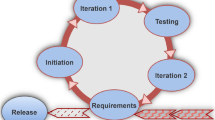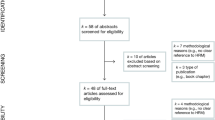Abstract
Agile software development that provides software development organizations, the ability to respond to changes in turbulent business environments, has been gaining wide adoption. Agile software development projects are characterized by ‘just enough’ planning and lack of upfront commitment to scope, cost, and schedule. These characteristics pose conflicting demands on managers responsible for making funding decisions, because traditional approaches to funding IT projects are often based on well-defined scope, cost, and schedule. These conflicts demand the adaptation of traditional funding processes to suit to agile projects. We draw from Adaptive Structuration Theory to understand the nature of conflicts between traditional IT project funding processes and the dynamic nature of agile projects, and how these conflicts are addressed by practices that are appropriated in the process of social interaction between funding decision makers and development teams. On the basis of a multisite case study, we present a framework that explains how organizations adapt traditional IT funding approaches to accommodate the unique characteristics of agile IT projects.

Similar content being viewed by others
References
Abrahamsson P, Warsta J, Siponen MT and Ronkainen J (2003) New directions on agile methods: a comparative analysis. In Proceedings of the 25th International Conference on Software Engineering, pp 244–254, IEEE Computer Society Portland, Oregon.
Adler PS, Goldoftas B and Levine DI (1999) Flexibility versus efficiency? A case study of model changeovers in the Toyota production system. Organization Science 10 (1), 43–68.
Anson R and Bostrom R (1995) An experiment assessing group support system and facilitator effects on meeting outcomes. Management Science 41 (2), 189–208.
Apostolopoulos TK and Pramataris KC (1997) Information technology investment evaluation: investments in telecommunication infrastructure. International Journal of Information Management 17 (4), 287–296.
Arbin K (2008) The structure of determinants of individual adoption and use of e-ordering systems. Human Systems Management 27 (2), 143–159.
Bacon CJ (1992) The use of decision criteria in selecting information system. MIS Quarterly 16 (3), 335–354.
Beck K and Fowler M (2001) Planning Extreme Programming. Addison Wesley Longman, New York, NY.
Benaroch M (2002) Managing information technology investment risk: a real options perspective. Journal of Management Information Systems 19 (2), 43–84.
Billingsley J (1989) An analysis of small group appropriation of decision structures in a computer-assisted group decision support environment. In International Communication Association Annual Meeting. San Francisco, CA.
Bostrom RP, Gupta S and Thomas D (2009) A meta-theory for understanding information systems within sociotechnical systems. Journal of Management Information Systems 26 (1), 17–47.
Brealey RA and Myers SC (1991) Principles of Corporate Finance. McGraw-Hill, Inc., New York.
Cao L, Mohan K, Peng X and Ramesh B (2009) A framework for adapting agile development methodologies. European Journal of Information Systems 18 (4), 332–343.
Chidambaram L, Bostrom RP and Wynne BE (1990) A longitudinal study of the impact of group decision support systems on group development. Journal of Management Information Systems 7 (3), 7–25.
Chin WW, Gopal A and Salisbury WD (1997) Advancing the theory of adaptive structuration: the development of a scale to measure faithfullness of appropriation. Information Systems Research 8 (4), 342–367.
Cockburn A (2001) Agile software development. In The Agile Software Development Series (Cockburn A and Highsmith J, Eds), Addison Wesley Longman, Massachusetts.
Denne M and Cleland-Huang J (2004) The incremental funding method: data-driven software development. IEEE Software 21 (3), 39–47.
Dennis AR and Garfield MJ (2003) The adoption and use of GSS in project teams: toward more participative processes and outcomes. MIS Quarterly 27 (2), 289–323.
DeSanctis G and Poole MS (1994) Capturing the complexity in advanced technology use: adaptive structuration theory. Organization Science 5 (2), 121–147.
DeSanctis G, Poole MS, Lewis H and Desharnais G (1991) Using computing in quality team meetings: initial observations from the IRS – Minnesota project. Journal of Management Information Systems 8 (3), 7–26.
DeSanctis G, Poole MS, Zigurs I, DeSharnais G, D′Onofrio M, Gallupe B, Holmes M, Jackson B, Jackson M, Lewis H, Imayem M, Lee-Partridge J, Niederman F, Sambamurthy V, Vician C, Watson R, Billingsley J, Kirsch L, Lind R and Shannon D (2008) The Minnesota GDSS research project: group support systems, group processes, and outcomes. Journal of the Association for Information Systems 9 (10), 551–608.
Dos Santos BL (1991) Justifying investments in new information technologies. Journal of Management Information Systems 7 (4), 71–89.
Eisenhardt KM (1989) Building theories from case study research. Academy of Management Review 14 (4), 532–550.
Emery DR and Finnerty JD (1991) Principles of Finance with Corporate Applications. West Publishing Company, St. Paul, MN.
Fitzgerald B, Hartnett G and Conboy K (2006) Customising agile methods to software practices at intel shannon. European Journal of Information Systems 15 (2), 200–213.
Gilbert CG (2006) Change in the presence of residual fit: can competing frames coexist? Organization Science 17 (1), 150–167.
Gopal A, Bostrom RP and Chin WW (1992) Applying adaptive structuration theory to investigate the process of group support systems use. Journal of Management Information Systems 9 (3), 45–69.
Gupta S and Bostrom RP (2009) Technology-mediated learning: a comprehensive theoretical model. Journal of the Association for Information Systems 10 (9), 686–714.
Highsmith J and Cockburn A (2001) Agile software development: the business of innovation. IEEE Computer 34 (9), 120–122.
Hill NS, Bartol KM, Tesluk PE and Langa GA (2009) Organizational context and face-to-face interaction: influences on the development of trust and collaborative behaviors in computer-mediated groups. Organizational Behavior & Human Decision Processes 108 (2), 187–201.
Lerouge C and Webb HW (2004) Appropriating enterprise resource planning systems in colleges of business: extending adaptive structuration theory for testability. Journal of Information Systems Education 15 (3), 315–326.
Levine L, Baskerville R, Loveland Link JL, Pries-Heje J, Ramesh B and Slaughter S (2002) Discovery Colloquium: Quality Software Development @ Internet Speed. Software Engineering Institute, Pittsburgh, PA.
Lewis MW (2000) Exploring paradox: toward a more comprehensive guide. Academy of Management Review 25 (4), 760–777.
Lubatkin MH, Simsek Z, Yan L and Veiga JF (2006) Ambidexterity and performance in small- to medium-sized firms: the pivotal role of top management team behavioral integration. Journal of Management 32 (5), 646–672.
Markus ML and Silver MS (2008) A foundation for the study of it effects: a new look at Desanctis and Poole's concepts of structural features and spirit. Journal of the Association for Information Systems 9 (10), 609–632.
Maruping LM, Xiaojun Z and Venkatesh V (2009) Role of collective ownership and coding standards in coordinating expertise in software project teams. European Journal of Information Systems 18 (4), 355–371.
Maznevski ML and Chudoba KM (2000) Bridging space over time: global virtual team dynamics and effectiveness. Organization Science 11 (5), 473–492.
Miles MB and Huberman AM (1994) Qualitative Data Analysis. Sage Publications, Thousand Oaks, CA.
Nagasundaram M and Bostrom RP (1994) The structuring of creative processes using gss: a framework for research. Journal of Management Information Systems 11 (3), 87–114.
Niederman F, Briggs RO, de Vreede G-J and Kolfschoten GL (2008) Extending the contextual and organizational elements of adaptive structuration theory in gss research. Journal of the Association for Information Systems 9 (10), 633–652.
Orlikowski WJ (1993) Case tools as organizational change: investigating incremental and radical changes in systems development. MIS Quarterly 17 (3), 309–340.
Paré G (2004) Investigating information systems with positivist case study research. Communications of AIS (13), 233–264.
Parker MM and Benson RJ (1988) Information Economics: Linking Business Performance to Information Technology. Prentice Hall, Englewood Cliffs, NJ.
Patton MP (1990) Qualitative Evaluation and Research Methods. Sage, London.
Pawlowski S and Robey D (2004) Bridging user organizations: knowledge brokering and the work of information technology professionals1. MIS Quarterly 28 (4), 645–645.
Payton FC and Kiwanuka-Tondo J (2009) Contemplating public policy in hiv/aids online content, then where is the technology spirit?. European Journal of Information Systems 18 (3), 192–204.
Project Management Institute (PMI) (2008) A Guide to the Project Management Body of Knowledge (4th edn), PMBOK Guide®. Project Management Institute.
Post GV, Kagan A and Lau K-N (1995) A modeling approach to evaluating strategic uses of information technology. Journal of Management Information Systems 12 (2), 161–187.
Reinig BA and Shin B (2002) The dynamic effects of group support systems on group meetings. Journal of Management Information Systems 19 (2), 303–325.
Salisbury WD, Chin WW, Gopal A and Newsted PR (2002) Research report: better theory through measurement – developing a scale to capture consensus on appropriation. Information Systems Research 13 (1), 91–103.
Sambamurthy V (1989) Supporting group performance during stakeholder analysis: The effects of alternative computer-based designs. p 314, Doctoral Dissertation, University Of Minnesota.
Schwieger D, Melcher A, Ranganathan C and Wen HJ (2004) Appropriating electronic billing systems: adaptive structuration theory analysis. Human Systems Management 23 (4), 235–243.
Strauss A and Corbin J (1990) Basics of Qualitative Research: Grounded Theory Procedures and Techniques. Sage Publication, London.
Thomas JC and Baker SW (2008) Establishing an agile portfolio to align it investments with business needs. Agile Conference, pp 252–258, IEEE Computer Society, Toronto, ON.
Vidgen R and Xiaofeng W (2009) Coevolving systems and the organization of agile software development. Information Systems Research 20 (3), 355–376.
Wallace L and Keil M (2004) Software projects risks and their effect on outcomes. Communications of the ACM 47 (4), 68–73.
Weill P (1991) The information technology payoff: implications for investment appraisal. Australian Accounting Review 1 (1), 2–11.
Weill P and Broadbent M (1998) Leveraging the New Infrastructure: How Market Leaders Capitalize on Information Technology. Harvard Business School Press, Boston.
Weill P and Olson MH (1989) Managing investment in information technology: mini case examples and implications. MIS Quarterly 13 (1), 3–18.
Yin RK (2003) Case Study Research: Design and Methods. Sage Publications, London.
Zigurs I, Desanctis G and Billingsley J (1991) Adoption patterns and attitudinal development in computer-supported meetings: an exploratory study with SAMM. Journal of Management Information Systems 7 (4), 51–70.
Author information
Authors and Affiliations
Rights and permissions
About this article
Cite this article
Cao, L., Mohan, K., Ramesh, B. et al. Adapting funding processes for agile IT projects: an empirical investigation. Eur J Inf Syst 22, 191–205 (2013). https://doi.org/10.1057/ejis.2012.9
Received:
Revised:
Accepted:
Published:
Issue Date:
DOI: https://doi.org/10.1057/ejis.2012.9




